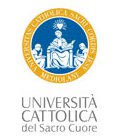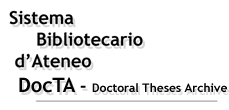|
|
DocTA - Doctoral Theses Archive >
Tesi di dottorato >
CORSO DI DOTTORATO IN PERSONA, SVILUPPO, APPRENDIMENTO. PROSPETTIVE EPISTEMOLOGICHE, TEORICHE ED APPLICATIVE AFFERENTE ALLA SCUOLA DI DOTTORATO IN SCIENZE DELLA FORMAZIONE >
Citazione:
Utilizza queste indicazioni per citare o creare un link a questo documento.
|
Savazzi, Federica. "Intersubjectivity and art", Università Cattolica del Sacro Cuore, XXIV ciclo, a.a. 2010/11, Milano, [http://hdl.handle.net/10280/1331].
|
| Titolo: | Intersubjectivity and art |
| Autore/i: | SAVAZZI, FEDERICA |
| Tutor: | FREEDBERG, DAVID
GILLI, GABRIELLA |
| Coordinatore: | MARCHETTI, ANTONELLA |
| Lingua: | ENG |
| Abstract in italiano della tesi: | L’esperienza estetica è un fenomeno complesso e articolato, caratterizzato da un particolare intreccio di processi percettivi, emotivi, cognitivi. Il dibattito sulla definizione del ruolo dei fattori che intervengono nell’esperienza estetica è molto controverso: diverse cornici teoriche enfatizzano o il ruolo dei fattori "bottom-up", riguardanti le caratteristiche visive e strutturali dell'opera d'arte come il colore e simmetria, o il ruolo dei fattori "top-down", relativi al bagaglio di conoscenze ed esperienze personali. Questa tesi presenta due studi volti ad approfondire, attraverso l'analisi dei movimenti oculari, l'influenza dei processi "bottom-up" e "top-down" sul comportamento visivo di adolescenti o adulti non esperti d’arte durante l'osservazione di opere d’arte pittorica. I dati ottenuti suggeriscono che processi intersoggettivi e relazionali giocano un ruolo essenziale nel guidare l’apprezzamento estetico di un quadro. Questi risultati innovativi supportano alcune recenti ipotesi teoriche relative alla natura intrinsecamente intersoggettiva dell’esperienza estetica. |
| Abstract in inglese: | Experiencing art is a complex and articulated phenomenon characterized by a peculiar weaving of perceptive, emotional, and cognitive processes. The debate on the definition of factors that contribute to the surfacing of an aesthetic experience is very controversial, partly because of the different weights assigned to the elements in the competition between “bottom-up” and “top-down” processes. Different theoretical frames emphasize the role of bottom-up factors - concerning the visual and structural characteristics of the artwork such as colour and symmetry - or top-down cognitive processes - concerning the cognitive feedback deriving from everyone’s cultural background and knowledge - in the building up of an aesthetic experience. In this work, two studies aiming at shedding some light on art appreciation are presented. These studies were designed to investigate, by means of the analysis of eye-movements, the influence of bottom-up and top-down processes on visual behavior while adolescents or adults naïve to art criticism were presented with representational paintings. Data suggest that intersubjective and relational processes intervene in first stages of aesthetic experience. These important and novel results support new theoretical proposals, which consider embodied intersubjective processes underpinning aesthetic experience. |
| Data di discussione: | 8-mar-2012 |
| URI: | http://hdl.handle.net/10280/1331 |
| È visualizzato nelle collezioni: | CORSO DI DOTTORATO IN PERSONA, SVILUPPO, APPRENDIMENTO. PROSPETTIVE EPISTEMOLOGICHE, TEORICHE ED APPLICATIVE AFFERENTE ALLA SCUOLA DI DOTTORATO IN SCIENZE DELLA FORMAZIONE
FACOLTA' DI SCIENZE DELLA FORMAZIONE
|
File in questo documento:
| File |
Dimensioni | Formato | Accessibilità |
|---|
| tesiphd_completa_Savazzi.pdf | 2,24 MB | Adobe PDF | non consultabile
|
|
Accesso e utilizzo dei contenuti di DocTA
|



